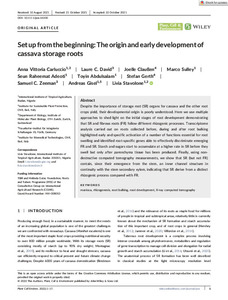| dc.contributor.author | Carluccio, A. |
| dc.contributor.author | David, L.C. |
| dc.contributor.author | Claußen, J. |
| dc.contributor.author | Sulley, M. |
| dc.contributor.author | Adeoti, S.R. |
| dc.contributor.author | Abdulsalam, T. |
| dc.contributor.author | Gerth, S. |
| dc.contributor.author | Zeeman, S.C. |
| dc.contributor.author | Gisel, A. |
| dc.contributor.author | Stavolone, L. |
| dc.date.accessioned | 2022-05-05T11:53:07Z |
| dc.date.available | 2022-05-05T11:53:07Z |
| dc.date.issued | 2022 |
| dc.identifier.citation | Carluccio, A., David, L.C., Claußen, J., Sulley, M., Adeoti, S.R., Abdulsalam, T., ... & Stavolone, L. (2022). Set up from the beginning: the origin and early development of cassava storage roots. Plant, Cell and Environment, 1-17. |
| dc.identifier.issn | 0140-7791 |
| dc.identifier.uri | https://hdl.handle.net/20.500.12478/7441 |
| dc.description.abstract | Despite the importance of storage root (SR) organs for cassava and the other root crops yield, their developmental origin is poorly understood. Here we use multiple approaches to shed light on the initial stages of root development demonstrating that SR and fibrous roots (FR) follow different rhizogenic processes. Transcriptome analysis carried out on roots collected before, during and after root bulking highlighted early and specific activation of a number of functions essential for root swelling and identified root-specific genes able to effectively discriminate emerging FR and SR. Starch and sugars start to accumulate at a higher rate in SR before they swell but only after parenchyma tissue has been produced. Finally, using non-destructive computed tomography measurements, we show that SR (but not FR) contain, since their emergence from the stem, an inner channel structure in continuity with the stem secondary xylem, indicating that SR derive from a distinct rhizogenic process compared with FR. |
| dc.description.sponsorship | Bill & Melinda Gates Foundation |
| dc.format.extent | 1-17 |
| dc.language.iso | en |
| dc.subject | Roots |
| dc.subject | Development |
| dc.subject | Cassava |
| dc.subject | Manihot Esculenta |
| dc.subject | Dna |
| dc.subject | Rna |
| dc.title | Set up from the beginning: the origin and early development of cassava storage roots |
| dc.type | Journal Article |
| cg.contributor.crp | Roots, Tubers and Bananas |
| cg.contributor.affiliation | International Institute of Tropical Agriculture |
| cg.contributor.affiliation | Institute for Sustainable Plant Protection, Italy |
| cg.contributor.affiliation | Institute of Molecular Plant Biology, Switzerland |
| cg.contributor.affiliation | Fraunhofer‐Institut für Integrierte Schaltungen IIS |
| cg.contributor.affiliation | Institute for Biomedical Technologies, Italy |
| cg.coverage.region | Africa |
| cg.coverage.region | West Africa |
| cg.coverage.country | Nigeria |
| cg.coverage.hub | Headquarters and Western Africa Hub |
| cg.researchtheme | Biotech and Plant Breeding |
| cg.identifier.bibtexciteid | CARLUCCIO:2022 |
| cg.isijournal | ISI Journal |
| cg.authorship.types | CGIAR and advanced research institute |
| cg.iitasubject | Agronomy |
| cg.iitasubject | Cassava |
| cg.iitasubject | Food Security |
| cg.iitasubject | Plant Breeding |
| cg.iitasubject | Plant Production |
| cg.journal | Plant, Cell and Environment |
| cg.notes | Open Access Article; Published online: 01 Mar 2022 |
| cg.accessibilitystatus | Open Access |
| cg.reviewstatus | Peer Review |
| cg.usagerightslicense | Creative Commons Attribution 4.0 (CC BY 0.0) |
| cg.targetaudience | Scientists |
| cg.identifier.doi | https://dx.doi.org/10.1111/pce.14300 |
| cg.iitaauthor.identifier | ANDREAS GISEL: 0000-0001-7218-9488 |
| cg.iitaauthor.identifier | LIVIA STAVOLONE: 0000-0002-0691-1302 |
| cg.futureupdate.required | No |
| cg.contributor.acknowledgements | The authors are grateful to Anetor Omonuwa and Brandon Harris for excellent technical assistance, and to Peter Iluebbey and IITA Cassava Breeding Unit for logistic support on the fieldwork. This study was supported by the Bill and Melinda Gates Foundation through the grant INV-008053 'Metabolic Engineering of Carbon Pathways to Enhance Yield of Root and Tuber Crops' and Roots and Tubers Programme (RTB) of the Consultative Group on International Agricultural Research (CGIAR). |

